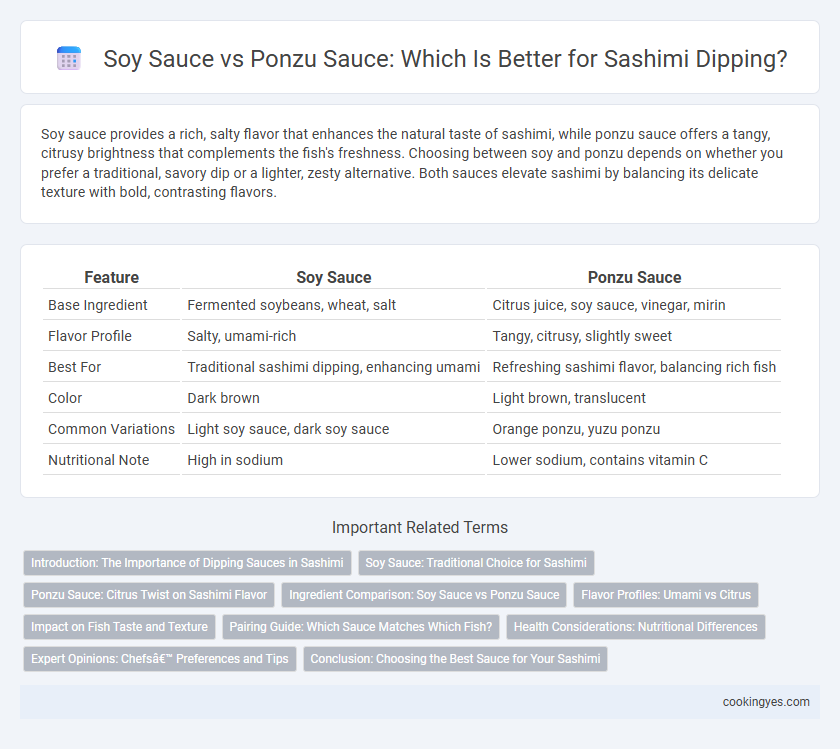Soy sauce provides a rich, salty flavor that enhances the natural taste of sashimi, while ponzu sauce offers a tangy, citrusy brightness that complements the fish's freshness. Choosing between soy and ponzu depends on whether you prefer a traditional, savory dip or a lighter, zesty alternative. Both sauces elevate sashimi by balancing its delicate texture with bold, contrasting flavors.
Table of Comparison
| Feature | Soy Sauce | Ponzu Sauce |
|---|---|---|
| Base Ingredient | Fermented soybeans, wheat, salt | Citrus juice, soy sauce, vinegar, mirin |
| Flavor Profile | Salty, umami-rich | Tangy, citrusy, slightly sweet |
| Best For | Traditional sashimi dipping, enhancing umami | Refreshing sashimi flavor, balancing rich fish |
| Color | Dark brown | Light brown, translucent |
| Common Variations | Light soy sauce, dark soy sauce | Orange ponzu, yuzu ponzu |
| Nutritional Note | High in sodium | Lower sodium, contains vitamin C |
Introduction: The Importance of Dipping Sauces in Sashimi
Dipping sauces play a crucial role in enhancing the delicate flavors of sashimi, balancing its fresh, raw taste with complementary seasonings. Soy sauce, traditionally rich and salty, deepens umami while preserving the fish's natural texture. Ponzu sauce, with its citrusy and tangy profile, offers a refreshing contrast that brightens sashimi, catering to varied palate preferences.
Soy Sauce: Traditional Choice for Sashimi
Soy sauce remains the traditional choice for sashimi dipping due to its rich umami flavor that enhances the natural taste of fresh fish. Its salty, slightly sweet profile complements a variety of sashimi types, from fatty tuna to mild white fish, making it a versatile condiment. Crafted through fermentation of soybeans, wheat, and salt, authentic soy sauce adds depth without overpowering the delicate texture of sashimi.
Ponzu Sauce: Citrus Twist on Sashimi Flavor
Ponzu sauce offers a refreshing citrus twist to sashimi, enhancing the natural flavors with its tangy and slightly sweet profile. Made from a blend of citrus juice, soy sauce, rice vinegar, and dashi, ponzu provides a bright contrast that complements delicate raw fish. This sauce elevates the sashimi experience by adding complexity and a zesty finish without overpowering the subtle taste of the seafood.
Ingredient Comparison: Soy Sauce vs Ponzu Sauce
Soy sauce for sashimi primarily contains fermented soybeans, wheat, salt, and water, creating a rich, salty, and umami flavor profile that enhances the fish's natural taste. Ponzu sauce combines soy sauce with citrus juice, rice vinegar, and dashi, resulting in a tangy, slightly sweet, and refreshing flavor that complements lighter sashimi varieties. The choice between soy sauce and ponzu sauce depends on whether a stronger umami punch or a brighter, acidic balance best suits the sashimi.
Flavor Profiles: Umami vs Citrus
Soy sauce offers a rich umami flavor that enhances the natural taste of sashimi with its deep, salty notes. Ponzu sauce provides a bright citrusy tang combined with subtle umami from ingredients like soy sauce and dashi, creating a refreshing contrast. Choosing between soy sauce and ponzu depends on whether you prefer a traditional umami punch or a zesty, acidic complement to delicate raw fish.
Impact on Fish Taste and Texture
Soy sauce imparts a rich umami flavor that enhances the natural taste of sashimi while maintaining the fish's delicate texture. Ponzu sauce adds a citrusy tang with a slightly acidic bite, which can brighten the sashimi's flavor profile and provide a refreshing contrast without overpowering the fish's softness. The choice between soy and ponzu influences the overall sensory experience, with soy emphasizing depth and saltiness and ponzu offering a zesty, lighter complement to raw fish.
Pairing Guide: Which Sauce Matches Which Fish?
Soy sauce's rich umami flavor enhances fattier sashimi like salmon and tuna, balancing their oily texture perfectly. Ponzu sauce's citrusy brightness complements lighter, delicate fish such as sea bream and yellowtail, adding a refreshing tang that cuts through subtle flavors. For a traditional pairing, use soy sauce with maguro (tuna) and ponzu with hamachi (yellowtail) to elevate the taste experience.
Health Considerations: Nutritional Differences
Soy sauce contains higher sodium levels, which can contribute to increased blood pressure when consumed in excess, while ponzu sauce generally has a lower sodium content due to its citrus-based ingredients. Ponzu sauce also provides vitamin C and antioxidants derived from its citrus components, offering additional health benefits not present in traditional soy sauce. Both sauces add flavor to sashimi but choosing ponzu may support better cardiovascular health and enhanced nutrient intake.
Expert Opinions: Chefs’ Preferences and Tips
Expert chefs often prefer soy sauce for sashimi due to its rich umami that enhances the natural flavors of fresh fish, while some favor ponzu sauce for its citrusy brightness that adds a refreshing contrast. Renowned sushi chefs recommend using light soy sauce varieties to avoid overpowering delicate sashimi textures, whereas ponzu's acidity pairs exceptionally well with fattier cuts like toro. Professional tips include dipping sashimi lightly into soy sauce for balanced taste and using ponzu sparingly to maintain the fish's subtle sweetness without masking its quality.
Conclusion: Choosing the Best Sauce for Your Sashimi
Soy sauce offers a rich umami flavor that enhances the natural taste of sashimi, making it a traditional and popular choice. Ponzu sauce provides a citrusy, tangy brightness that complements lighter fish varieties and adds a refreshing zest. Selecting the best sauce depends on personal taste preferences and the type of sashimi, with soy sauce suited for bold flavors and ponzu ideal for a lighter, more vibrant dipping experience.
Soy Sauce vs Ponzu Sauce for sashimi dipping Infographic

 cookingyes.com
cookingyes.com